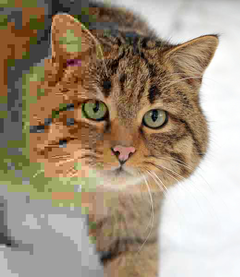JPG

A photo of a cat with the compression rate decreasing, and hence quality increasing, from left to right.
|
|
| Filename extension |
.jpg, .jpeg, .jpe.jif, .jfif, .jfi
|
|---|---|
| Internet media type | image/jpeg |
| Type code | JPEG |
| Uniform Type Identifier (UTI) | public.jpeg |
| Magic number | ff d8 ff |
| Developed by | Joint Photographic Experts Group |
| Initial release | September 18, 1992 |
| Type of format | lossy image format |
| Standard | ISO/IEC 10918, ITU-T T.81, ITU-T T.83, ITU-T T.84, ITU-T T.86 |
| Website | www |
|
|
JPEG (/ˈdʒeɪpɛɡ/ JAY-peg) is a commonly used method of lossy compression for digital images, particularly for those images produced by digital photography. The degree of compression can be adjusted, allowing a selectable tradeoff between storage size and image quality. JPEG typically achieves 10:1 compression with little perceptible loss in image quality.
JPEG compression is used in a number of image file formats. JPEG/Exif is the most common image format used by digital cameras and other photographic image capture devices; along with JPEG/JFIF, it is the most common format for storing and transmitting photographic images on the World Wide Web. These format variations are often not distinguished, and are simply called JPEG.
The term "JPEG" is an initialism/acronym for the Joint Photographic Experts Group, which created the standard. The MIME media type for JPEG is image/jpeg, except in older Internet Explorer versions, which provides a MIME type of image/pjpeg when uploading JPEG images. JPEG files usually have a filename extension of .jpg or .jpeg.
...
Wikipedia
